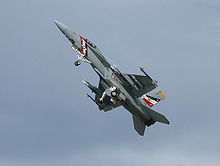F-18 E/F Super Hornet
The Boeing F/A-18E/F Super Hornet is a twin-engine 4.5 generation carrier-based multirole fighter aircraft. The F/A-18E single-seat variant and F/A-18F tandem-seat variant are larger and more advanced derivatives of the F/A-18C and D Hornet. The Super Hornet has an internal 20 mm gun and can carry air-to-air missiles and air-to-surface weapons. Additional fuel can be carried with up to five external fuel tanks and the aircraft can be configured as an airborne tanker by adding an external air refueling system.Designed and initially produced by McDonnell Douglas, the Super Hornet first flew in 1995. Full-rate production began in September 1997, after the merger of McDonnell Douglas and Boeing the previous month. The Super Hornet entered service with the United States Navy in 1999, replacing the F-14 Tomcat since 2006, and serves alongside the original Hornet. The Royal Australian Air Force ordered F/A-18F Super Hornets in 2007 to replace its aging F-111 fleet and began receiving aircraft in March 2010.
Beginning in 2005, new build aircraft received the APG-79 AESA radar. Earlier production aircraft will have their APG-73 replaced with the APG-79.As of January 2008, 135 earlier production aircraft were to receive AESA radar retrofits. VFA-213 "Black Lions" and VFA-106 "Gladiators" based at Oceana Naval Air Station were the first two squadrons to fly the AESA-equipped Super Hornets.The new APG-79 AESA radar offers several advantages for the Super Hornet. The new radar enables the aircrew to execute simultaneous air-to-air and air-to-ground attacks. The APG-79 also provides higher quality high-resolution ground mapping at long standoff ranges.The AESA radar can also detect smaller targets, such as inbound missiles and can track air targets beyond the range of the Super Hornet's own air to air missiles. VFA-213 became "safe for flight" (independently fly and maintain the F/A-18F) on 27 October 2006 and is the first Super Hornet squadron to fly AESA-equipped Super Hornets.VFA-213 is the first squadron to receive the Dual-Cockpit Cueing System for both pilot and Weapon systems officer.The JHMCS provides multi-purpose aircrew situational awareness including high-off-bore-sight cueing of the AIM-9X Sidewinder missile. Shared Reconnaissance Pod (SHARP) is a high-resolution, digital tactical air reconnaissance system that features advanced day/night and all-weather capability.In the future, air-to-air target detection using Infrared Search and Track (IRST) in the form of a passive, long range sensor that detects long wave IR emissions will be an option with a unique solution. Survivability is an important feature of the Super Hornet design. The US Navy took a "balanced approach" to survivability in its design. This means that it does not rely on low-observable technology, such as stealth systems, to the exclusion of other survivability factors. Instead, its design incorporates a combination of stealth, advanced electronic-warfare capabilities, reduced ballistic vulnerability, the use of standoff weapons, and innovative tactics that cumulatively and collectively enhance the safety of the fighter and crew.The F/A-18E/F's radar cross section was reduced greatly from some aspects, mainly the front and rear. The design of the engine inlets reduces the aircraft's frontal radar cross section. The alignment of the leading edges of the engine inlets is designed to scatter radiation to the sides. Fixed fanlike reflecting structures in the inlet tunnel divert radar energy away from the rotating fan blades.The Super Hornet also makes considerable use of panel joint serration and edge alignment. Considerable attention has been paid to the removal or filling of unnecessary surface join gaps and resonant cavities. Where the F/A-18A-D used grilles to cover various accessory exhaust and inlet ducts, the F/A-18E/F uses perforated panels that appear opaque to radar waves at the frequencies used. Careful attention has been paid to the alignment of many panel boundaries and edges, to scatter traveling waves away from the aircraft.
